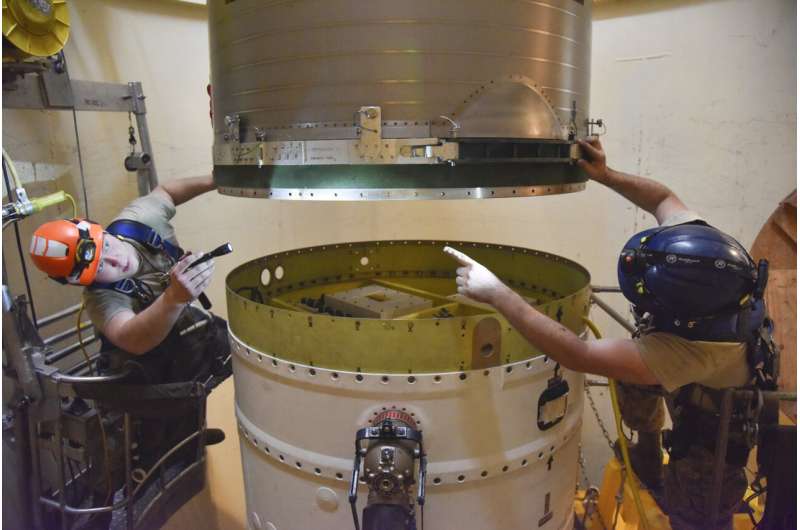This article has been reviewed according to Science X's editorial process and policies. Editors have highlighted the following attributes while ensuring the content's credibility:
fact-checked
reputable news agency
proofread
Carcinogens found at Montana nuclear missile sites as reports of hundreds of cancers surface

The Air Force has detected unsafe levels of a likely carcinogen at underground launch control centers at a Montana nuclear missile base where a striking number of men and women have reported cancer diagnoses.
A new cleanup effort has been ordered.
The discovery "is the first from an extensive sampling of active U.S. intercontinental ballistic missile bases to address specific cancer concerns raised by missile community members," Air Force Global Strike Command said in a release Monday. In those samples, two launch facilities at Malmstrom Air Force Base in Montana showed PCB levels higher than the thresholds recommended by the Environmental Protection Agency.
PCBs are oily or waxy substances that have been identified as a likely carcinogen by the EPA. Non-Hodgkin lymphoma is a blood cancer that uses the body's infection-fighting lymph system to spread.
In response, Gen. Thomas Bussiere, commander of Air Force Global Strike Command, has directed "immediate measures to begin the cleanup process for the affected facilities and mitigate exposure by our airmen and Guardians to potentially hazardous conditions."
After a military briefing was obtained by The Associated Press in January showing that at least nine current or former missileers at Malmstrom were diagnosed with non-Hodgkin lymphoma, a rare blood cancer, the Air Force School of Aerospace Medicine launched a study to look at cancers among the entire missile community checking for the possibility of clusters of the disease.
And there could be hundreds more cancers of all types, based on new data from a grassroots group of former missile launch officers and their surviving family members.
According to the Torchlight Initiative, at least 268 troops who served at nuclear missile sites, or their surviving family members, have self-reported being diagnosed with cancer, blood diseases or other illnesses over the past several decades.
At least 217 of those reported cases are cancers, at least 33 of them non-Hodgkin lymphoma.
What's notable about those reported numbers is that the missileer community is very small. Only a few hundred airmen serve as missileers at each of the country's three silo-launched Minuteman III intercontinental ballistic missile bases any given year. There have been only about 21,000 missileers in total since the Minuteman operations began in the early 1960s, according to the Torchlight Initiative.
For some context, in the U.S. general population there are about 403 new cancer cases reported per 100,000 people each year, according to the Centers for Disease Control and Prevention, and non-Hodgkin lymphoma affects an estimated 19 of every 100,000 people annually, according to the American Cancer Society.
Minutemen III silo fields are based at Malmstrom, F.E. Warren Air Force Base in Wyoming and Minot Air Force Base in North Dakota.
Missileers are male and female military officers who serve in underground launch control centers where they are responsible for monitoring, and if needed, launching fields of silo-based nuclear weapons. Two missileers spend sometimes days at a time on watch in underground bunkers, ready to turn the key and fire Minuteman III intercontinental ballistic missiles if ordered to do so by the president.
The Minuteman III silos and underground control centers were built more than 60 years ago. Much of the electronics and infrastructure is decades old. Missileers have raised health concerns multiple times over the years about ventilation, water quality and potential toxins they cannot avoid as they spend 24 to 48 hours on duty underground.
The Air Force discovery of PCBs occurred as part of site visits by its bioenvironmental team from June 22 to June 29 in the Air Force's ongoing larger investigation into the number of cancers reported among the missile community. During the site visits a health assessment team collected water, soil, air and surface samples from each of the missile launch facilities.
At Malmstrom, of the 300 surface swipe samples, 21 detected PCBs. Of those, 19 were below levels set by the EPA requiring mitigation and two were above. No PCBs were detected in any of the 30 air samples. The Air Force is still waiting for test results from F.E. Warren and Minot for surface and air samples, and for all bases for the water and soil samples.
© 2023 The Associated Press. All rights reserved. This material may not be published, broadcast, rewritten or redistributed without permission.
















